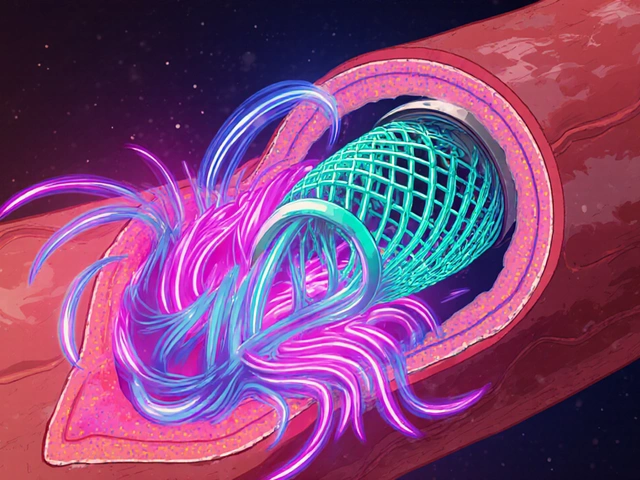Right after a heart attack, some people find their heart starts beating way out of rhythm. That’s not just uncomfortable—it can be flat out dangerous. Fast, irregular, or stalled heartbeats can turn up in the hours or days following a heart attack. This is where amiodarone shows up as a potential lifesaver.
Maybe you’ve heard amiodarone called a “big gun” when it comes to stabilizing heart rhythm. It’s true. Doctors pick it when other medications just aren’t cutting it or when patients can’t handle standard drugs. People who suddenly feel their heart race or slow after a heart attack aren’t just dealing with stress—they’re at risk for something life-threatening. That’s why knowing how amiodarone fits into the picture isn’t just medical trivia—it’s personal.
The thing is, this drug isn’t for everyone, and it isn’t trouble-free. Still, for someone who’s just had a heart attack and is suddenly facing weird heartbeats, it’s usually better to sort it out earlier than later. It can buy precious time while the root cause is handled. But it’s not one-size-fits-all—knowing when to use it, what side effects to watch, and how to keep living well matters just as much as knowing what the medication does.
- Why Heart Rhythms Go Haywire After a Heart Attack
- The Basics of Amiodarone: How It Works
- When Doctors Reach for Amiodarone
- Tips for Living Well on Amiodarone
- What Side Effects Should You Watch Out For?
- Weighing the Risks: Making the Right Choice
Why Heart Rhythms Go Haywire After a Heart Attack
When you have a heart attack, some of the heart muscle loses its blood flow and starts to die. That part of the heart just isn’t the same anymore. Damaged muscle can’t carry the electrical signals your heart depends on to keep a regular beat. These mixed-up signals are what lead to arrhythmias—those fast, slow, or totally off-beat heart rhythms.
Here’s the deal: after a myocardial infarction (that’s “heart attack” in medical talk), your risk of serious arrhythmias like ventricular tachycardia or ventricular fibrillation jumps, especially in the first 48 hours. These aren’t just odd sensations—they can lead to sudden cardiac arrest. That’s why hospitals monitor heart rhythm so closely after someone comes in with chest pain.
- Scar tissue from a heart attack can block or detour the normal electrical path.
- Low oxygen in the heart tissue can make the cells cranky and unpredictable.
- Chemical imbalances, like low potassium or magnesium, make things worse.
Not everyone gets arrhythmias after a heart attack, but if you do, it’s a red flag. According to recent hospital data, about 10% of people with heart attacks develop a serious arrhythmia before leaving the hospital. Some will need fast treatment with a medicine like amiodarone to calm things down before things get out of hand.
The bottom line? Even if you feel okay after a heart attack, those electrical problems aren’t always obvious. That’s why close heart monitoring is a must, and it’s also why knowing about post-MI arrhythmia can actually save your life.
The Basics of Amiodarone: How It Works
If you’re reading up on amiodarone, you’re probably wondering what makes it the go-to when heartbeats spiral out of control. To put it simply, amiodarone works by slowing down the electrical signals in your heart. When those signals fire off too quickly or in the wrong pattern, your heart can race, flutter, or even stop beating the way it’s supposed to. That’s where this drug steps in to help get things back on track.
Amiodarone isn’t just another blood pressure pill. It’s a powerful antiarrhythmic—meaning it targets abnormal heart rhythms head-on. It blocks certain electrical channels in your heart, kind of like putting up detour signs on a busy road, so the signals travel the right way and at the right speed. This makes it useful for lots of dangerous rhythms like ventricular tachycardia (crazy fast heartbeats from the lower part of your heart) and atrial fibrillation (those jumpy, twitchy beats up top).
Here’s why doctors like to have it in the toolkit after a myocardial infarction: It doesn’t mess with your blood pressure as much as some other drugs. That’s a big deal when your heart’s already taken a hit. It also has a long half-life, so you don’t need to take it many times a day—sometimes once, sometimes twice, depending on your setup.
Check out how amiodarone stacks up in the real world:
| Feature | Amiodarone | Other Antiarrhythmics |
|---|---|---|
| Helps with both fast and irregular rhythms? | Yes | Sometimes |
| Works without dropping blood pressure? | Usually | No |
| Dose per day | 1-2 | 2-4 |
| Commonly used after heart attack? | Yes | Less often |
It’s not magic, though. Amiodarone builds up in your body slowly. Sometimes you get a "loading dose"—a bigger amount at first, so it kicks in faster. After that, maintenance doses keep the arrhythmia away. This stepwise approach helps balance results with risk.
When Doctors Reach for Amiodarone
Doctors don’t just hand out amiodarone after every heart attack. They use it for tricky rhythm problems when the usual options, like beta-blockers, don’t cut it. The big reason? Amiodarone can handle both fast and slow arrhythmias, especially ones that show up after a myocardial infarction (heart attack).
The two big troublemakers after a heart attack are ventricular tachycardia (VT) and ventricular fibrillation (VF). Both can be deadly if not stopped quickly. Amiodarone is often the drug of choice if a patient doesn’t respond to first-line treatments or if those drugs make their low blood pressure worse. It doesn’t mess with the heart’s pumping strength as much as some older drugs.
- Emergency use: Doctors turn to amiodarone in emergencies, like when the electric shock (defibrillation) isn’t working or keeps needing to be repeated. It’s given through an IV in the hospital.
- Ongoing rhythm problems: If someone keeps getting dangerous arrhythmias days or weeks after their heart attack, they might be sent home on pill forms of amiodarone.
- Can’t use standard meds: Maybe someone can’t handle beta-blockers or other antiarrhythmics because of allergies, asthma, or bad side effects. Amiodarone sometimes steps in.
To get a clearer picture, here’s how amiodarone is used compared to other antiarrhythmics after a heart attack:
| Drug | Works for Both VT & VF? | Blood Pressure Effects | Main Route in Acute Emergency |
|---|---|---|---|
| Amiodarone | Yes | Rarely lowers too much | IV |
| Lidocaine | Mainly VT | Can lower moderately | IV |
| Beta-blockers | Sometimes | Often lowers | Tablet/IV |
Doctors are careful with amiodarone, though. They look at how bad the arrhythmia is, what other health problems you have, and how you did with past heart meds. Bottom line: If your heart’s acting wildly after a heart attack and nothing else is working, amiodarone often becomes the go-to rescue.

Tips for Living Well on Amiodarone
Getting used to amiodarone after a heart attack can take some effort, but there are a bunch of ways to make it easier. Let’s cut to the chase: this medicine has a big job, but you have a lot of control over how you handle it day-to-day.
- Stick with your checkups. Amiodarone isn’t a “set it and forget it” type of medication. You’ll need regular blood work, check-ins with your doctor, and at least a yearly eye exam. Thyroid and liver tests are especially important since amiodarone can mess with both. Missing checkups can mean problems sneak up on you.
- Watch for side effects. Keep a lookout for persistent cough, shortness of breath, vision changes, or unusual tiredness. Tell your doctor if you notice any of these.
- Sun safety isn’t optional. This drug makes your skin extra sensitive to sunlight, meaning you could burn or get a rash faster than usual. Slather on sunscreen (SPF 30 or higher), wear hats, and cover up if you’re outside.
- Stay on schedule. Missing doses can mess up heart rhythm control. Set phone alarms or use a pillbox. If you forget a dose, don’t double up. Just get back on track with the next one.
- Be honest about other meds. Amiodarone doesn’t play nice with a lot of drugs. It can boost levels of blood thinners, certain cholesterol meds, and even some antibiotics. Always double-check with your pharmacist or doctor before starting anything new.
- Avoid grapefruit. Seriously—this isn’t just a random food warning. Grapefruit juice can mess with how your body handles amiodarone, making side effects much more likely.
Here’s a quick snapshot of common labs doctors will monitor if you’re on amiodarone:
| Test Name | How Often | Why |
|---|---|---|
| Liver Function Test | Every 3-6 months | Detects liver issues early |
| Thyroid Panel | Every 6 months | Checks for hormone changes |
| Chest X-ray | Yearly | Looks for lung side effects |
| Eye Exam | Yearly | Monitors vision changes |
| EKG | At least yearly | Tracks your heart rhythm |
Don’t be shy about telling your team if you’re feeling off, even if you’re not sure it’s the amiodarone. Small problems can turn into big ones without early help. And don’t just quit the medicine on your own—suddenly stopping can be risky after a myocardial infarction. Communication with your care team is just as important as taking your pills.
What Side Effects Should You Watch Out For?
Amiodarone isn’t like your average heart pill. It’s a heavy hitter, and with that comes a laundry list of side effects. If you’re starting amiodarone after a heart attack, you’ve got to know what symptoms are just a nuisance and which ones scream for a call to your doctor.
The classic side effects of amiodarone tend to pop up in different body systems. Some show up quickly, while others sneak up months later. Here’s what you need to keep an eye on:
- Lung troubles: Cough, shortness of breath, or chest pain can mean lung inflammation. This is serious—don’t ignore it.
- Thyroid changes: Amiodarone messes with thyroid hormones, swinging them high or low. Watch for sudden weight gain or loss, feeling crazy tired, restless, or sweaty, and talk to your doctor about regular thyroid tests.
- Liver issues: Weird tiredness, dark pee, yellow skin (jaundice), or pain under your ribs is reason to check in—these could point to liver trouble.
- Skin reactions: Sunburn from just walking to your mailbox and a blue-gray tint to your skin show up in a chunk of long-term users. Up your sunscreen game and try to cover up on sunny days.
- Vision changes: Blurry vision, halos around lights, or eye pain can be signs that the drug is going after your eyes.
- Digestive problems: Nausea, loss of appetite, or upset stomach are pretty common but not as dangerous. Still, if it gets bad, let your provider know.
- Heart rhythm changes: Ironically, amiodarone can sometimes throw off your heart’s rhythm in new ways. Lightheadedness or fainting isn’t normal, so flag it right away.
About 1 in 10 people will eventually run into a problem big enough that doctors have to stop the drug. That’s why ongoing blood work, lung checks, and eye exams are part of the deal with amiodarone.
| Side Effect | Approximate Rate |
|---|---|
| Lung problems | 5-10% |
| Skin discoloration/photosensitivity | 25-40% |
| Thyroid dysfunction | 10-20% |
| Liver dysfunction | 3-5% |
| Vision changes | 4-10% |
With amiodarone, the key is not to tough it out if something feels wrong. Report anything new—especially trouble breathing, vision changes, or weird skin color. Staying on top of potential side effects can save you from bigger problems down the road.
Weighing the Risks: Making the Right Choice
Choosing amiodarone after a heart attack isn’t a light decision. Sure, the drug can calm down wild heart rhythms, but it also brings some baggage. That’s why talking honestly with your doctor about what matters most to you is key. Do you want to feel as steady as possible, or are you more worried about long-term side effects?
Doctors look at a bunch of factors when recommending amiodarone for post-MI arrhythmia. Here’s what usually goes into that call:
- Risk of arrhythmia turning deadly: If the heartbeat problem could cause sudden death, treating fast matters more than worrying about long-term risks.
- What other heart meds you’re on: Some common drugs don’t mix well with amiodarone. Your doctor checks for clashes.
- Current health of other organs: Lungs, liver, thyroid, and eyesight can all take a hit from this medicine. If you already have issues, it changes the balance.
- Personal lifestyle: If you’re an outdoorsy person, amiodarone’s sun sensitivity side effect might be a bigger deal for you.
Want numbers? In one well-known study called EMIAT, people with abnormal heart rhythms after a heart attack who took amiodarone saw a reduction in sudden cardiac death by about 35%. But here’s the kicker — that same study showed no real difference in overall survival compared to those not taking amiodarone. So, while it’s great at preventing certain deadly rhythms, it won’t solve everything.
| Benefit | Potential Risk |
|---|---|
| Stops dangerous arrhythmias fast | Lung scarring in 1-2% of patients |
| Can be used when standard meds fail | Thyroid issues in 15-20% |
| Works even in sick hearts | Liver problems in 1-5% |
If you decide to move ahead with amiodarone, regular blood work and check-ups are non-negotiable. Most folks have thyroid and liver checks every 6 months, plus chest X-rays at least once a year, since sneaky side effects can show up later.
People sometimes ask, “Is there ever a point where it just isn’t worth it?” If side effects start to cause more trouble than the arrhythmia itself, or if other options turn up, the answer is yes. No shame in switching gears.
End of the day, the right call comes down to your unique story. Stay open with your care team, ask plenty of questions, weigh the facts, and remember—when it comes to post-MI arrhythmia, there’s rarely a one-size-fits-all fix.






Kajal Gupta
April 23, 2025 AT 09:51Wow, this rundown on amiodarone really hits the spot. I love how you broke down the why‑after‑MI arrhythmias happen, it’s crystal clear. The tables make the comparison easy to swallow, and the tip about sun safety is a lifesaver. For anyone juggling meds post‑heart attack, those check‑up reminders are pure gold. Keep spreading the knowledge, it makes a difference.
Zachary Blackwell
April 23, 2025 AT 12:04They don't want you to know how amiodarone is actually a covert tool in the pharma agenda.
prithi mallick
April 23, 2025 AT 14:17Honestly this article feels like a gentle hand guiding a scared heart. It reminds me that each beat is a lesson, and we cant just ignore the whispers of the body. Thanks for the thorough guide.
Michaela Dixon
April 23, 2025 AT 16:31Amiodarone is like the Swiss army knife of anti‑arrhythmics it can tackle ventricular tachycardia and atrial fibrillation with equal poise It works by slowing down the electrical currents in the heart so the chaotic signals calm down It’s especially handy after a myocardial infarction when the heart tissue is bruised and erratic The drug’s long half‑life means you don’t have to pop a pill every few hours which is a blessing for patients dealing with recovery stress The loading dose gets the medicine into the system quickly and then the maintenance dose keeps things steady While the benefits are clear the side‑effect profile is a bit of a double‑edged sword The thyroid can go haywire the liver might protest and the skin becomes photosensitive making a sunny day a potential hazard Monitoring labs like thyroid panels liver function tests and eye exams becomes part of the routine care plan The good news is that with diligent follow‑up many issues can be caught early and managed The risk of lung toxicity, though rare, is something doctors keep an eye on especially if a patient develops a persistent cough The drug also interacts with a host of other medications so a thorough medication review is essential The cost can be a factor for some but many insurance plans cover it because of its life‑saving potential The decision to start amiodarone often comes after beta‑blockers or other agents have fallen short It’s a calculated gamble balancing immediate rhythm control against long‑term organ effects The patient’s lifestyle matters too if they love outdoor activities the sun sensitivity can be a dealbreaker The literature shows a roughly 35% reduction in sudden cardiac death in high‑risk post‑MI patients taking amiodarone but no big change in overall survival The key takeaway is that amiodarone is a powerful tool that works best when paired with vigilant monitoring and patient education.
Dan Danuts
April 23, 2025 AT 18:44Great point Kajal! I totally agree that the sun‑safety tip can’t be overstated – a simple sunscreen stash can save you from months of skin trouble. Let’s keep the conversation going and help more folks stay on top of their check‑ups.
Dante Russello
April 23, 2025 AT 20:57Excellent deep dive on amiodarone!; Your breakdown of the benefits versus risks is spot‑on; I especially appreciate the emphasis on regular labs and eye exams; It’s crucial for patients to stay vigilant; Thanks for the thorough analysis;
James Gray
April 23, 2025 AT 23:11Hey everyone, just wanted to shout out the part about loading doses – that’s the secret sauce that gets amiodarone working fast; also the reminder to avoid grapefruit is super helpful; keep the tips coming, it’s all gold for anyone on this meds.
Scott Ring
April 24, 2025 AT 01:24I hear you, James – the grapefruit warning can be easy to forget, especially when you’re juggling a bunch of dietary changes; I always set a reminder on my phone to double‑check drug‑food interactions.
Shubhi Sahni
April 24, 2025 AT 03:37Thanks for the clear summary on side‑effects; regular monitoring really does make a difference; appreciate the thoroughness;.
Danielle St. Marie
April 24, 2025 AT 05:51Honestly this post feels like a textbook rewrite by a pharma‑sponsored writer 🙄📚.
keerthi yeligay
April 24, 2025 AT 08:04Interesting take, but the science behind amiodarone’s arrhythmia control is well‑documented; it's not some secret plot, just solid pharmacology.
Peter Richmond
April 24, 2025 AT 10:17In summary, amiodarone remains a critical option for post‑MI arrhythmia management, provided that comprehensive monitoring protocols are adhered to.